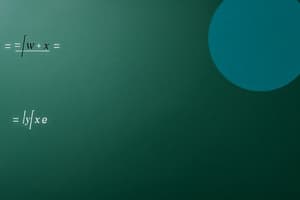Podcast
Questions and Answers
Which of the following describes a finite set?
Which of the following describes a finite set?
- A set with unlimited elements.
- A set where all elements are the same.
- A set with no elements.
- A set containing a limited number of elements. (correct)
What is the result of the intersection of two sets A and B, denoted as A ∩ B?
What is the result of the intersection of two sets A and B, denoted as A ∩ B?
- Elements found only in set B.
- Elements found in both set A and set B. (correct)
- All elements from set A.
- All unique elements from both sets.
How is the complement of set A, denoted as A', defined?
How is the complement of set A, denoted as A', defined?
- The set of elements in A.
- The set of all elements in the universe.
- The set of all elements in A and B.
- The set of elements not in A, relative to a universal set U. (correct)
In set notation, which of the following is an example of the roster method?
In set notation, which of the following is an example of the roster method?
What is the cardinality of the empty set?
What is the cardinality of the empty set?
Which operation results in a set that includes elements in set A that are not in set B?
Which operation results in a set that includes elements in set A that are not in set B?
In a Venn diagram, what do overlapping areas between circles represent?
In a Venn diagram, what do overlapping areas between circles represent?
What notation is used to describe properties of elements in a set?
What notation is used to describe properties of elements in a set?
Flashcards are hidden until you start studying
Study Notes
Set Theory
- Definition: A set is a collection of distinct objects, considered as an object in its own right.
- Elements: Objects in a set are called elements or members.
- Notation: Sets are usually denoted by uppercase letters (e.g., A, B), while elements are listed in curly braces (e.g., A = {1, 2, 3}).
- Types of Sets:
- Finite Set: Contains a limited number of elements (e.g., {1, 2, 3}).
- Infinite Set: Contains unlimited elements (e.g., {1, 2, 3, ...}).
- Empty Set: A set with no elements, denoted by ∅ or {}.
- Subset: A set A is a subset of B if all elements of A are also in B (A ⊆ B).
Operations On Sets
- Union (A ∪ B): Combines all elements from both sets, excluding duplicates.
- Intersection (A ∩ B): Contains elements common to both sets.
- Difference (A - B): Contains elements in A that are not in B.
- Complement (A'): Contains elements not in set A, relative to a universal set U.
Venn Diagrams
- Purpose: Visual representation of sets and their relationships.
- Components: Circles represent sets, overlapping areas indicate intersections.
- Usage: Useful for illustrating unions, intersections, and differences visually.
Cardinality
- Definition: The number of elements in a set.
- Finite Sets: The cardinality is simply the count of distinct elements.
- Infinite Sets: Cardinality can vary (e.g., countably infinite sets like natural numbers vs. uncountably infinite sets like real numbers).
- Notation: Denoted by |A|, where A is the set.
Set Notation
- Roster Method: Listing all elements (e.g., A = {2, 4, 6}).
- Set-builder Notation: Describing properties of elements (e.g., B = {x | x is an even integer}).
- Universal Set: The set that contains all possible elements in a particular context, denoted by U.
- Special Sets:
- Natural Numbers (N): {1, 2, 3, ...}
- Integers (Z): {..., -3, -2, -1, 0, 1, 2, 3, ...}
- Rational Numbers (Q): Numbers that can be expressed as a fraction p/q, where p and q are integers and q ≠ 0.
Set Theory
- A set is a distinct collection of objects, recognized as a single entity.
- Elements are the individual items within a set, also known as members.
- Sets are represented by uppercase letters, while elements are enclosed in curly braces (e.g., A = {1, 2, 3}).
Types of Sets
- Finite Set: Contains a specific number of elements (e.g., {1, 2, 3}).
- Infinite Set: Comprises an unlimited number of elements (e.g., {1, 2, 3,...}).
- Empty Set: A set that has no elements, symbolized by ∅ or {}.
- Subset: Set A is a subset of B if every element in A is also an element of B, denoted A ⊆ B.
Operations On Sets
- Union (A ∪ B): Merges all elements from sets A and B, removing duplicates.
- Intersection (A ∩ B): Contains only the elements that are present in both sets A and B.
- Difference (A - B): Comprises elements in set A that are absent in set B.
- Complement (A'): Includes elements not found in set A, within the context of a universal set U.
Venn Diagrams
- Serve as visual tools to illustrate sets and the relationships among them.
- Sets are depicted as circles, with intersections represented in overlapping areas.
- Effective for visually demonstrating unions, intersections, and differences among sets.
Cardinality
- Refers to the total number of elements in a given set.
- For finite sets, cardinality is the straightforward count of distinct elements.
- Infinite sets can have varying cardinality, distinguishing between countably infinite (e.g., natural numbers) and uncountably infinite (e.g., real numbers).
- Notation for cardinality is |A|, where A represents the particular set.
Set Notation
- Roster Method: Directly lists all elements of a set (e.g., A = {2, 4, 6}).
- Set-builder Notation: Describes sets by specifying properties of their elements (e.g., B = {x | x is an even integer}).
- Universal Set: Encompasses all conceivable elements in a given context, represented by U.
- Special Sets:
- Natural Numbers (N): The set of positive integers {1, 2, 3,...}.
- Integers (Z): The set of whole numbers, including negatives, zero, and positives {..., -3, -2, -1, 0, 1, 2, 3,...}.
- Rational Numbers (Q): Includes numbers expressible as a fraction p/q, where both p and q are integers and q ≠ 0.
Studying That Suits You
Use AI to generate personalized quizzes and flashcards to suit your learning preferences.




